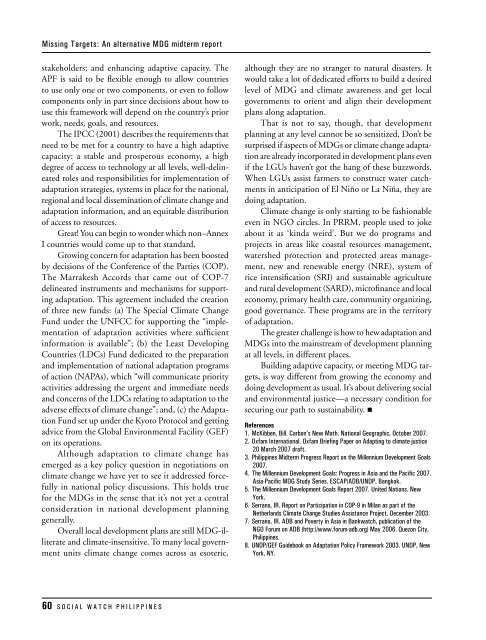one big file - Social Watch
one big file - Social Watch
one big file - Social Watch
You also want an ePaper? Increase the reach of your titles
YUMPU automatically turns print PDFs into web optimized ePapers that Google loves.
Missing Targets: An alternative MDG midterm report<br />
stakeholders; and enhancing adaptive capacity. The<br />
APF is said to be flexible enough to allow countries<br />
to use only <strong>one</strong> or two comp<strong>one</strong>nts, or even to follow<br />
comp<strong>one</strong>nts only in part since decisions about how to<br />
use this framework will depend on the country’s prior<br />
work, needs, goals, and resources.<br />
The IPCC (2001) describes the requirements that<br />
need to be met for a country to have a high adaptive<br />
capacity: a stable and prosperous economy, a high<br />
degree of access to technology at all levels, well-delineated<br />
roles and responsibilities for implementation of<br />
adaptation strategies, systems in place for the national,<br />
regional and local dissemination of climate change and<br />
adaptation information, and an equitable distribution<br />
of access to resources.<br />
Great! You can begin to wonder which non–Annex<br />
I countries would come up to that standard.<br />
Growing concern for adaptation has been boosted<br />
by decisions of the Conference of the Parties (COP).<br />
The Marrakesh Accords that came out of COP-7<br />
delineated instruments and mechanisms for supporting<br />
adaptation. This agreement included the creation<br />
of three new funds: (a) The Special Climate Change<br />
Fund under the UNFCC for supporting the “implementation<br />
of adaptation activities where sufficient<br />
information is available”; (b) the Least Developing<br />
Countries (LDCs) Fund dedicated to the preparation<br />
and implementation of national adaptation programs<br />
of action (NAPAs), which “will communicate priority<br />
activities addressing the urgent and immediate needs<br />
and concerns of the LDCs relating to adaptation to the<br />
adverse effects of climate change”; and, (c) the Adaptation<br />
Fund set up under the Kyoto Protocol and getting<br />
advice from the Global Environmental Facility (GEF)<br />
on its operations.<br />
Although adaptation to climate change has<br />
emerged as a key policy question in negotiations on<br />
climate change we have yet to see it addressed forcefully<br />
in national policy discussions. This holds true<br />
for the MDGs in the sense that it’s not yet a central<br />
consideration in national development planning<br />
generally.<br />
Overall local development plans are still MDG-illiterate<br />
and climate-insensitive. To many local government<br />
units climate change comes across as esoteric,<br />
although they are no stranger to natural disasters. It<br />
would take a lot of dedicated efforts to build a desired<br />
level of MDG and climate awareness and get local<br />
governments to orient and align their development<br />
plans along adaptation.<br />
That is not to say, though, that development<br />
planning at any level cannot be so sensitized. Don’t be<br />
surprised if aspects of MDGs or climate change adaptation<br />
are already incorporated in development plans even<br />
if the LGUs haven’t got the hang of these buzzwords.<br />
When LGUs assist farmers to construct water catchments<br />
in anticipation of El Niño or La Niña, they are<br />
doing adaptation.<br />
Climate change is only starting to be fashionable<br />
even in NGO circles. In PRRM, people used to joke<br />
about it as ‘kinda weird’. But we do programs and<br />
projects in areas like coastal resources management,<br />
watershed protection and protected areas management,<br />
new and renewable energy (NRE), system of<br />
rice intensification (SRI) and sustainable agriculture<br />
and rural development (SARD), microfinance and local<br />
economy, primary health care, community organizing,<br />
good governance. These programs are in the territory<br />
of adaptation.<br />
The greater challenge is how to hew adaptation and<br />
MDGs into the mainstream of development planning<br />
at all levels, in different places.<br />
Building adaptive capacity, or meeting MDG targets,<br />
is way different from growing the economy and<br />
doing development as usual. It’s about delivering social<br />
and environmental justice—a necessary condition for<br />
securing our path to sustainability. •<br />
References<br />
1. McKibben, Bill. Carbon’s New Math. National Geographic, October 2007.<br />
2. Oxfam International. Oxfam Briefing Paper on Adapting to climate justice<br />
20 March 2007 draft.<br />
3. Philippines Midterm Progress Report on the Millennium Development Goals<br />
2007.<br />
4. The Millennium Development Goals: Progress in Asia and the Pacific 2007.<br />
Asia-Pacific MDG Study Series. ESCAP/ADB/UNDP. Bangkok.<br />
5. The Millennium Development Goals Report 2007. United Nations. New<br />
York.<br />
6. Serrano, IR. Report on Participation in COP-9 in Milan as part of the<br />
Netherlands Climate Change Studies Assistance Project. December 2003.<br />
7. Serrano, IR. ADB and Poverty in Asia in Bankwatch, publication of the<br />
NGO Forum on ADB (http://www.forum-adb.org) May 2006. Quezon City,<br />
Philippines.<br />
8. UNDP/GEF Guidebook on Adaptation Policy Framework 2003. UNDP, New<br />
York, NY.<br />
60 S O C I A L W A T C H P H I L I P P I N E S

















